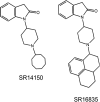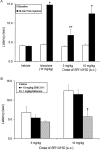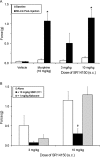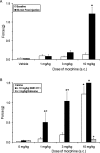Differential effects of nociceptin/orphanin FQ (NOP) receptor agonists in acute versus chronic pain: studies with bifunctional NOP/μ receptor agonists in the sciatic nerve ligation chronic pain model in mice
- PMID: 21859931
- PMCID: PMC3199991
- DOI: 10.1124/jpet.111.184663
Differential effects of nociceptin/orphanin FQ (NOP) receptor agonists in acute versus chronic pain: studies with bifunctional NOP/μ receptor agonists in the sciatic nerve ligation chronic pain model in mice
Abstract
1-(1-Cyclooctylpiperidin-4-yl)-indolin-2-one (SR14150) and 1-(1-(2,3,3a,4,5,6-hexahydro-1H-phenalen-1-yl)piperidinl-4-yl)-indolin-2-one (SR16835) are moderately selective nociceptin/orphanin FQ (NOP) receptor agonists. In the [(35)S]guanosine 5'-O-(3-thiotriphosphate) assay in vitro, SR14150 is a partial agonist at both the NOP and μ-opioid receptors, whereas SR16835 is a full agonist at the NOP receptor and has low efficacy at μ receptors. These compounds were tested for antinociceptive and antiallodynic activity, using mice in chronic pain, subsequent to spinal nerve ligation (SNL) surgery. When administered subcutaneously to mice after SNL surgery, SR14150 but not SR16835 increased tail-flick latency, which was blocked by the opioid antagonist naloxone, but not by the NOP receptor antagonist (-)-cis-1-methyl-7-[[4-(2,6-dichlorophenyl)piperidin-1-yl]methyl]-6,7,8,9-tetrahydro-5H-benzocyclohepten-5-ol (SB-612111). In contrast, both SR14150 and SR16835 had antiallodynic activity when mechanical allodynia was measured with von Frey monofilaments. This effect was completely blocked by SB-612111 but not by naloxone. On the other hand, morphine antinociception and antiallodynia were both blocked by naloxone and potentiated by SB-612111. These results indicate that, in mice, circuitry mediating antinociceptive activity in acute and chronic pain states is different. It is possible that during a chronic pain state, an up-regulated NOP system in the spinal cord leads to NOP receptor-mediated antiallodynia, which is blocked by NOP antagonists. However, supraspinal up-regulation could lead to an attenuation of morphine antinociception and antiallodynia, which can be alleviated by an NOP receptor antagonist. Thus, although neither NOP agonists nor antagonists are effective as analgesics in acute pain, they may have efficacy as analgesics, either alone or in combination with morphine, for treatment of chronic pain.
Figures







Similar articles
-
Nociceptin/orphanin FQ receptor activation attenuates antinociception induced by mixed nociceptin/orphanin FQ/mu-opioid receptor agonists.J Pharmacol Exp Ther. 2009 Dec;331(3):946-53. doi: 10.1124/jpet.109.156711. Epub 2009 Aug 27. J Pharmacol Exp Ther. 2009. PMID: 19713488 Free PMC article.
-
Effects of spinally administered bifunctional nociceptin/orphanin FQ peptide receptor/μ-opioid receptor ligands in mouse models of neuropathic and inflammatory pain.J Pharmacol Exp Ther. 2013 Jul;346(1):11-22. doi: 10.1124/jpet.113.203984. Epub 2013 May 7. J Pharmacol Exp Ther. 2013. PMID: 23652222 Free PMC article.
-
Comparison of the antinociceptive and antirewarding profiles of novel bifunctional nociceptin receptor/mu-opioid receptor ligands: implications for therapeutic applications.J Pharmacol Exp Ther. 2009 Dec;331(3):954-64. doi: 10.1124/jpet.109.157446. Epub 2009 Sep 22. J Pharmacol Exp Ther. 2009. PMID: 19773529 Free PMC article.
-
The biology of Nociceptin/Orphanin FQ (N/OFQ) related to obesity, stress, anxiety, mood, and drug dependence.Pharmacol Ther. 2014 Mar;141(3):283-99. doi: 10.1016/j.pharmthera.2013.10.011. Epub 2013 Nov 1. Pharmacol Ther. 2014. PMID: 24189487 Free PMC article. Review.
-
Central N/OFQ-NOP Receptor System in Pain Modulation.Adv Pharmacol. 2016;75:217-43. doi: 10.1016/bs.apha.2015.10.001. Epub 2015 Dec 17. Adv Pharmacol. 2016. PMID: 26920014 Free PMC article. Review.
Cited by
-
Nociceptin/orphanin FQ peptide receptor antagonist JTC-801 reverses pain and anxiety symptoms in a rat model of post-traumatic stress disorder.Br J Pharmacol. 2015 Jan;172(2):571-82. doi: 10.1111/bph.12701. Epub 2014 Jul 1. Br J Pharmacol. 2015. PMID: 24666365 Free PMC article.
-
The NOP Receptor System in Neurological and Psychiatric Disorders: Discrepancies, Peculiarities and Clinical Progress in Developing Targeted Therapies.CNS Drugs. 2021 Jun;35(6):591-607. doi: 10.1007/s40263-021-00821-0. Epub 2021 May 31. CNS Drugs. 2021. PMID: 34057709 Free PMC article. Review.
-
A novel orvinol analog, BU08028, as a safe opioid analgesic without abuse liability in primates.Proc Natl Acad Sci U S A. 2016 Sep 13;113(37):E5511-8. doi: 10.1073/pnas.1605295113. Epub 2016 Aug 29. Proc Natl Acad Sci U S A. 2016. PMID: 27573832 Free PMC article.
-
Comparison of Pharmacological Properties between the Kappa Opioid Receptor Agonist Nalfurafine and 42B, Its 3-Dehydroxy Analogue: Disconnect between in Vitro Agonist Bias and in Vivo Pharmacological Effects.ACS Chem Neurosci. 2020 Oct 7;11(19):3036-3050. doi: 10.1021/acschemneuro.0c00407. Epub 2020 Sep 24. ACS Chem Neurosci. 2020. PMID: 32897695 Free PMC article.
-
Nociceptin Opioid Receptor (NOP) as a Therapeutic Target: Progress in Translation from Preclinical Research to Clinical Utility.J Med Chem. 2016 Aug 11;59(15):7011-28. doi: 10.1021/acs.jmedchem.5b01499. Epub 2016 Mar 14. J Med Chem. 2016. PMID: 26878436 Free PMC article. Review.
References
-
- Barlocco D, Cignarella G, Giuseppe G, Grugni M, Ronzoni S. (2006) inventors; GlaxoSmithKline S.p.A., assignee. Benzosuberonylpiperidine compounds as analgesics. U.S. patent 7,115,633 2006 Oct 3
-
- Bertorelli R, Bastia E, Citterio F, Corradini L, Forlani A, Ongini E. (2002) Lack of the nociceptin receptor does not affect acute or chronic nociception in mice. Peptides 23:1589–1596 - PubMed
-
- Briscini L, Corradini L, Ongini E, Bertorelli R. (2002) Up-regulation of ORL-1 receptors in spinal tissue of allodynic rats after sciatic nerve injury. Eur J Pharmacol 447:59–65 - PubMed
-
- Carrà G, Rizzi A, Guerrini R, Barnes TA, McDonald J, Hebbes CP, Mela F, Kenigs VA, Marzola G, Rizzi D, et al. (2005) [(pF)Phe4,Arg14,Lys15]N/OFQ-NH2 (UFP-102), a highly potent and selective agonist of the nociceptin/orphanin FQ receptor. J Pharmacol Exp Ther 312:1114–1123 - PubMed
Publication types
MeSH terms
Substances
Grants and funding
LinkOut - more resources
Full Text Sources
Other Literature Sources
Medical
Research Materials
Miscellaneous

